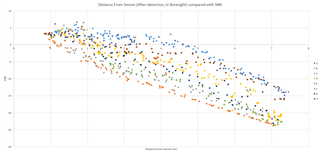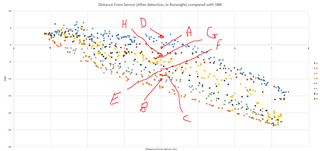Hi,
I have recently had a design manufactured which incorporated the IWR6843 with the patch antenna from the ISK Dev kit.
There are several changes in my design compared to the ISK dev kit, predominantly in power supply where independent buck converters were implemented with independent LDO regulators to supply all rails (3V3, 1V8, 1V2 and 1V0) to reduce noise.
The design closely follows the stack up from the ISK dev kit, including ENiAg finish and the PCBs were manufactured with IPC class three tolerance. Dielectric 1 (Rogers Material) was RO4835Lo Pro with 1/1 RA copper plated to 1.6mil on the top layer. The other layers were equivalent PCL370HR material, but in marginally different thicknesses from the ISK dev kit.
A batch of 50 units were made and tested using the standard 14m configuration that was provided with the ISK dev kit.
The sensors were mounted on the roof, and have tilt downward from the roof and are housed in tooled enclosures. Test were repeated with/without enclosures and results were identical.
Approximately 50% of these units were capable of detecting human targets at approximately 8-9m from the sensor when walking down the boresight towards the sensor. Also, these sensors were able to detect targets when moving in an arc with radii of 8-9m from the sensor once the targets entered the FOV (roughly +/-30-40 degrees from Boresight). All sensors could track targets (after detection within 0-8m) up till approximately 10m. These units are our high performers and are satisfactory to our goals.
Approximately 25% of these units were capable of detecting targets at 5-6m from the sensor when walking down the boresight towards the sensor. Also, these sensors were able to detect targets when moving in an arc with radii of 5-6m from the sensor once the targets entered the FOV (roughly +/-30-40 degrees from Boresight). All sensors could track targets (after detection within 0-5m) up till approximately 9-10m.These units are low performers and are minimally effective for our application.
Approximately 25% of these units were capable of detecting targets up to 4m from the sensor when walking down the boresight towards the sensor. Also, these sensors were able to detect targets when moving in an arc with radii of <4m from the sensor once the targets entered the FOV (roughly +/-30-40 degrees from Boresight). All sensors could track targets (after detection within <4m) up till approximately 8m. These units are not effective for our application.
We have looked into the average SNR for each target for the sensors, and although there is a clear trend in distance to SNR there is no significant difference in sensors which can detect from 0-4m to 0-8m.
The SNR tests were performed with trihedral corner reflectors at multiple distances down the sensors boresight.
The tracking seems to be effective, but the variability of the detection is my concern.
Previous manufactured designs had low performance detection, so in this current design we went to IPC Class 3, and used 1/1RA copper with ENiAg to match the ISK dev kit.
Using corner reflectors I can manually test the detection area, but I cannot seem to find a way to gauge the detection area based on the SNR or other metric from the IWR6843.
Is there any diagnostic information available to the IWR6843 that describes the antenna performance, detection area or other descriptive measure for estimated performance, or am I missing a calibration step which might improve the detection FOV?
Side note, higher temperature reflow of the IWR6843 does not improvethe detection performance. Swapping power circuitry with high performer's parts also has no appreciable effect on detection performance.
Thanks in advance
Matthew



